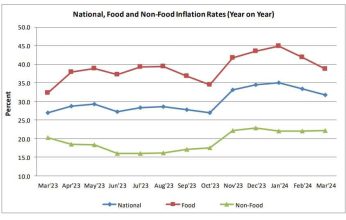EIU puts Malawi’s GDP growth at 4%
 Malawi’s real gross domestic product (GDP) growth this year is forecast to ease to four percent, according to the Economist Intelligence Unit (EIU), an independent business within the Economist Group.
Malawi’s real gross domestic product (GDP) growth this year is forecast to ease to four percent, according to the Economist Intelligence Unit (EIU), an independent business within the Economist Group.
This is a 2.6 percentage points shy of government’s projected growth of 6.6 percent announced by Malawi’s Finance Minister Ken Lipenga in the 2011/12 Mid-Year Budget Review.
In its March 2012 economic outlook for Malawi, the EIU has attributed the slow growth to maize production which will be constrained by problems encountered in the distribution of the subsidised fertiliser, slow uranium production, cuts in aid and foreign exchange shortages.
It said these factors will damage productivity with the economic uncertainty hindering overall investment.
“Growth will remain subdued in 2013, which is set to be a turbulent year as the exchange-rate policy unravels, although it is expected to increase marginally to 4.3 percent, supported by a modest recovery in aid,” the think-tank said.
But the economy is expected to recover further between 2014 and 2016, although not to the levels seen during President Bingu wa Mutharika’s first term between 2004 and 2009, said the EIU.
Malawi has in recent years seen GDP growth averaging 7.4 percent, thanks to a bumper harvest as a result of the implementation of the farm input subsidy programme which started in 2005, coupled with good rains.
In 2008, the economic growth peaked at a record 9.8 percent, touted as the fastest growing economy second to oil-rich Qatar.
Agriculture which has been pushing Malawi’s growth for a number of years is set to moderate to five percent by 2016 as the potential for raising maize output through fertiliser usage declines.
“The mining sector will grow slowly as exploration takes place for oil in Lake Malawi and for rare earth minerals, but uranium output stabilises. Growth in construction, manufacturing and services is expected to recover slightly as macroeconomic stability improves,” said the EIU report, forecasting overall growth of between 4.8 and 5.2 percent in 2014 to 2016.
The EIU said the downside risks to this are high, largely owing to the possibility of a severe drought, delays to the anticipated recovery in aid or a sharp slump in prices for Malawi’s main export, tobacco.
Malawi has been beset by a freeze in aid, which accounts for 40 percent of the budget since last year as several Western donors under the Common Approach to Budget Support (Cabs) have withheld funds due to economic and governance concerns.
The country is facing a $121 million (K20 billion) budget shortfall in the current financial year due, in part, to a lack an International Monetary Fund (IMF) programme, the $79.4 million Extended Credit Facility (ECF) which went off-track in June 2011.
Currently, life is becoming increasingly unbearable for most Malawians since last year due to shortages of foreign exchange that has resulted in challenges to procure essential commodities such as fuel and medicines.
Further, the EIU said Malawi’s infrastructure will remain inadequate, as public investment is curtailed by the tight fiscal situation.
But it said investment in infrastructure could pick up in the second half of the forecast period although the long gestation period for infrastructure projects will mean that the results are unlikely to be seen before 2016.
Public spending growth will be tightened in the financial year as the deterioration in donor-government relations leads to a decline in grants to 15 percent of revenue, from 23 percent of revenue in 2010/11 with capital spending bearing the brunt of this, falling by 25 percent, according to the EIU.
Despite government claiming the zero-deficit budget will be achieved, the EIU forecast a deficit of 1.6 percent of GDP in 2011/12.
Overall, it said the deficit is forecast to peak at 2.4 percent of GDP in 2013/14 before moderating to 1.3 percent of GDP in 2015/16.
“The deficits will be financed primarily with external concessional borrowing, although public domestic debt will also increase slightly.”





